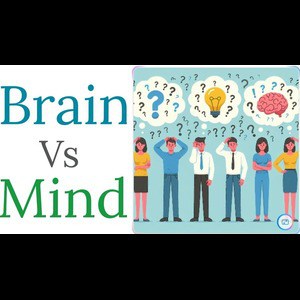Introduction
Today’s topic is the difference between the brain and mind. We will also discuss the levels of the mind and how they impact our lives. To make this clear, let’s compare the brain and mind to a computer or laptop.
Brain and Mind: A Computer Analogy
To understand the difference between the brain and the mind, let’s use a computer as an analogy.
The Brain: The Hardware
The brain is like the hardware of a computer—it’s tangible, something we can see and touch. Just as a computer has a physical structure made of circuits, chips, and hard drives, the brain is a solid organ in our body that we can physically touch and see. The brain’s structure includes neurons and synapses that form a complex network, much like the intricate wiring of a computer.
The Mind: The Software
On the other hand, the mind acts like the software and apps in a computer—something we can only use and process, but not physically touch. Just as software directs the computer’s operations, our mind directs our thoughts, feelings, and actions. It’s the intangible part that gives instructions to the hardware, enabling us to think, feel, and respond.
Insights from Neuroscience
Once, I had a conversation with a highly qualified neurologist. I asked him, “What exactly is the human mind according to neuroscience?” He explained that a functioning brain can be understood as the mind. The brain exists in a deceased person too, but it’s not functional. When the brain is active—thoughts, feelings, memories, beliefs, values all running through it—that’s when we refer to it as the mind.
Brain and Mind: Hardware and Software
Think of it this way: the brain is the hardware, and the mind is the software. Here’s some good news: there’s no difference between your brain and the brain of Bill Gates or Jeff Bezos. We all have similar brain structures. In NLP (Neuro-Linguistic Programming), we say we are born with the same neurology—the same number of neurons, the same potential. Yet, we achieve different levels of success.
Why the Difference in Success?
While our brains are similar, our minds are not. Our beliefs, values, and past experiences shape our thinking and belief systems, creating unique minds. An unsuccessful person holds different beliefs and values than an average person, and a successful person has yet another set of beliefs and values. The key difference lies in the mind.
The Importance of Updating Our Mind
Imagine you have the latest laptop with a powerful processor, ample RAM, and a huge hard disk. If you install outdated software like Windows 98 or XP, will you be able to use the laptop’s features to their fullest? No. Similarly, if you connect this laptop to the internet without antivirus protection, it will get corrupted. The same happens with our human brain. We have the latest hardware due to evolution, but many people don’t upgrade their minds. They live with outdated belief systems that no longer serve them in today’s world filled with negativity.
The Need for a Mental Antivirus
Do we have a mental antivirus to counter these negative influences? Most people don’t. That’s why we need to understand and upgrade our human mind—our software. We need to develop a mental antivirus to protect us, keep us motivated, and help us reach our goals.
Methods to Update the Mind
The best way to update the mind is to practice NLP and meditation. NLP helps us change our thoughts, beliefs, and values, gradually reviving our minds. Meditation also plays a crucial role in this process, helping us to focus and calm our minds, making it easier to implement positive changes.
The Levels of the Mind
The mind operates on three levels:
1. Conscious Mind
This is the part of our mind that is constantly engaged in processing thoughts and making decisions. It’s where our awareness resides, allowing us to consciously navigate and interact with the world around us through deliberate actions.
2. Subconscious Mind
Operating just below the surface of our awareness, the subconscious mind handles automatic functions essential to our survival, such as regulating breathing and heartbeat. It serves as a repository for our memories, beliefs, and learned behaviors, shaping our daily routines and responses to stimuli.
3. Unconscious Mind
Deeper still lies the unconscious mind, where instincts, primal urges, and deeply ingrained behavioral patterns reside. While we may not be consciously aware of its workings, the unconscious mind significantly influences our thoughts, emotions, and physiological processes, playing a crucial role in our overall well-being and decision-making.
Simplifying the Levels of the Mind
To simplify, we often refer to the mind in two parts: the conscious and the subconscious (which includes the unconscious). The conscious mind is what we actively use, while the subconscious mind controls automatic functions and processes.
Understanding and Managing Our Minds
Understanding these levels helps us better navigate our thoughts and behaviors. By working on updating our minds through practices like NLP and meditation, we can achieve a more balanced and fulfilling life.
Engaging with the Conscious Mind
The conscious mind is like the user interface of a computer—it’s what we interact with directly. We use it to make decisions, solve problems, and navigate the world around us. This part of the mind is crucial for learning new skills and adapting to changes in our environment.
Exploring the Subconscious Mind
Beneath the surface lies the subconscious mind, which is like the operating system of a computer. It runs in the background, managing numerous tasks without our conscious awareness. This includes regulating our bodily functions, storing memories, and shaping our habits and behaviors based on past experiences. The subconscious mind is incredibly powerful and can process information much faster than the conscious mind.
Delving into the Unconscious Mind
The unconscious mind delves even deeper. It’s like the core system files of a computer that are hidden from the user but essential for the overall functioning of the system. This part of the mind houses our most basic instincts and drives. It influences our behavior in ways we might not fully understand. Our unconscious mind can affect our decisions and reactions, often without us realizing it.
Working with the Levels of the Mind
By understanding and working with these different levels of the mind, we can better manage our thoughts and behaviors. For example, if we want to change a habit, we need to engage the subconscious mind, where habits are stored. This can be done through repetition, visualization, and other techniques that help to reprogram our subconscious.
Tools for Mind Transformation
NLP is a powerful tool for this purpose. It involves using language and other forms of communication to change our mental and emotional patterns. By altering our thoughts and beliefs, we can change our behavior and achieve our goals more effectively.
The Role of Meditation
Meditation is another effective way to work with the subconscious mind. It helps to calm the conscious mind, allowing us to access deeper levels of awareness. Through meditation, we can become more aware of our thoughts and feelings, and begin to change the patterns that no longer serve us.
Continuous Mind Updates
Updating our minds is a continuous process. Just as we regularly update our computer software to keep it running smoothly, we need to regularly update our minds to keep them functioning optimally. This involves learning new skills, challenging old beliefs, and adopting new perspectives.
Coping with Negative Influences
In today’s world, we are constantly bombarded with information and stimuli, much of which is negative. This can lead to mental clutter and stress, which in turn affects our overall well-being. By practicing techniques like NLP and meditation, we can develop a mental antivirus that helps us to filter out the negative influences and focus on what truly matters.
Conclusion
In summary, the brain is the hardware, and the mind is the software. While our brains are similar, our minds are unique, shaped by our beliefs, values, and experiences. By understanding the difference between the brain and the mind, and by working with the different levels of the mind, we can achieve greater success and fulfillment in our lives.
I hope this post has clarified the difference between the brain and the mind and the importance of updating our minds. In the next post, I will explain the different levels of the mind in more detail and how we can utilize this potential to create a difference in our lives. I’m excited to see you in the next post. Live the life you deserve!
Cheers to better mental health and continuous growth!



1 thought on “Difference Between Brain & Mind and Powerful Levels of Mind”